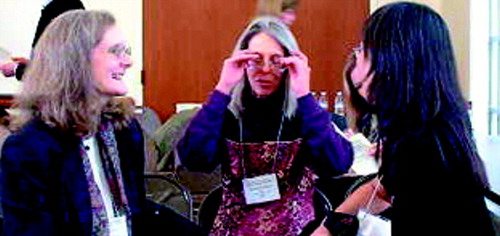Women in Health Care Build Support Network
Last October
The San Francisco Bay–area volunteer, who provided medical services to poor villagers in Mexico, was returning from one such effort when her plane crashed, killing Loewenstein and five colleagues. Loewenstein was 84.
In her courage and dedication, Loewenstein was not unlike many of the women who gathered at Mills College in Oakland, Calif., for a conference called “Advancing Women’s Leadership in Medicine, Health Sciences, and Health Care Careers.” The conference, held January 12 and 13, was dedicated to Loewenstein.
 The conference brought together more than 100 women with careers in health care—many of whom were physicians—who participated in discussion groups such as “Taking Care of Yourself” and “Thriving, Not Just Surviving—Sharing Our Stories.”
The conference brought together more than 100 women with careers in health care—many of whom were physicians—who participated in discussion groups such as “Taking Care of Yourself” and “Thriving, Not Just Surviving—Sharing Our Stories.”
APA’s women’s programs, which have grown in number over recent years, include the Women’s Mentoring Network, the Aventis 2001 Women Residents’ Travel Program, and APAWOMEN, the APA list serve for women members.
APA has also taken steps to increase its roster of women leaders by hiring
At the Mills College conference, McLoughlin listened to women talk about two common problems: advancement in academia and double standards. She noted, “While men are often given important advice on the promotion and tenure process, women are not.”
Participants, mostly women physicians, spoke about how they were not encouraged to publish research or pursue grants. They were quick to problem-solve, however.
“Our first solution was to write the unwritten rules and make sure they are visible,” commented McLoughlin. “The physicians in the group suggested that we create an interactive Web page with information about the different options that are available for women physicians.”
“These women coped with a lot of adversity in their lives,” said Mitchell, who noted that “some women spoke candidly about how they handled divorce when it came very unexpectedly, early in their careers, leaving them with young children and very demanding jobs.” There were also women physicians who spoke of trying to hold a marriage together when their careers took them away from their spouses, according to Mitchell.
“These women weren’t whining or feeling sorry for themselves,” said Mitchell, “but relaying the experiences of their lives.”
This is just what APA fellow
Murray, an assistant professor of psychiatry at the University of Washington, chaired a discussion group on “The Professional and the Personal—A Double Bind for Women,” something she knows all about. “I have been the Girl Scout leader and the school volunteer, and taken my parents back and forth to doctors’ appointments,” said Murray.
Life didn’t stop while she completed her second residency in psychiatry. “Along the way, I dealt with growing children and ailing parents,” she said. “Putting it all together was a challenge.”
Murray, who has chosen to work under 40 hours a week, shared some valuable lessons from her life experience. In her view, British psychoanalyst
Murray also bestowed another gem of wisdom on her fellow group members: “Calm down and make time for yourself.”
At the closing ceremony of the Mills College conference, Loewenstein’s family spoke about her life.
“Women at the conference saw through the example of
More information about APA’s programs for women can be found at www.psych.org/women. ▪



